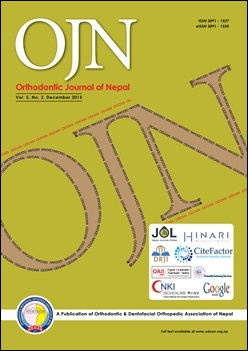Maxillary Canine Impactions in Orthodontic Patients: A Study
DOI:
https://doi.org/10.3126/ojn.v5i2.15219Keywords:
canine, impaction, prevalenceAbstract
Introduction: Dental anomalies involving alterations in number, size and structure of teeth often present a major challenge for dental practitioners. Many of these undiagnosed and untreated dental anomalies may ultimately present complex clinical problems in the areas of orthodontics, prosthodontics, endodontics and restorative dentistry. Maxillary canines are important aesthetically and functionally, but impacted ones are more difficult and time consuming to treat. Permanent maxillary canine impaction has been reported in 1-5% of the population.
Objective: To determine the prevalence of impacted maxillary canine in patients visiting to Dhulikhel Hospital, Kathmandu University School of Medical Sciences, Nepal.
Materials & Method: The study was conducted with a total number of 341 orthodontic patients. The study consisted of clinical and radiographic examinations of the patients who visited Department for Orthodontics for orthodontic treatment. Descriptive statistics was calculated for gender groups and anatomical positions of the impacted canine.
Result: A total of 18 (5.29%) orthodontic patients (male 5.83%, female 5.0%) were found to have maxillary canine impaction.
Conclusion: The prevalence of impacted maxillary canines in Nepalese orthodontic patients is 5.29%. The occurrence is slightly higher in males
Downloads
Downloads
Published
How to Cite
Issue
Section
License
Copyright © held by Orthodontic & Dentofacial Orthopedic Association of Nepal
- Copyright on any research article is transferred in full to the Orthodontic & Dentofacial Orthopedic Association of Nepal upon publication in the journal. The copyright transfer includes the right to reproduce and distribute the article in any form of reproduction (printing, electronic media or any other form).
- Articles in the Orthodontic Journal of Nepal are Open Access articles published under the Creative Commons CC BY License (https://creativecommons.org/licenses/by/4.0/)
- This license permits use, distribution and reproduction in any medium, provided the original work is properly cited.




